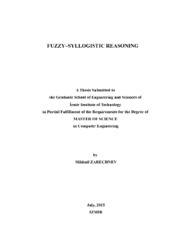Please use this identifier to cite or link to this item:
https://hdl.handle.net/11147/4332| Title: | Fuzzy-Syllogistic Reasoning | Other Titles: | Bulanık Tasımsal Çıkarsama | Authors: | Zarechnev, Mikhail | Advisors: | Kumova, Bora İsmail | Keywords: | Fuzzy mathematics | Publisher: | Izmir Institute of Technology | Source: | Zarechnev, M. (2015). Fuzzy-syllogistic reasoning. Unpublished master's thesis, İzmir Institute of Technology, İzmir, Turkey | Abstract: | A syllogism is a formal logical scheme used to infer a conclusion from a set of
premises. In a categorical syllogism, there are only two premises and each premise and
conclusion is given in form a of quantity-quantified relationship between two objects.
Different order of objects in premises produce a classification known as syllogistic
figures. Ordered combinations of 3 quantifiers with a certain figure, known as moods,
provide 256 combinations in total. However, only 25 of them are valid, i.e. conclusion
follows from premises. The classical syllogistic system allows to model human thought
as reasoning with syllogistic structures. However, a major lack is that there is still no
systems that allow to arrive at a decision of syllogisms automatically. This work is an
attempt to design a fully algorithmic approach that allows to calculate properties of a
whole syllogistic system and provide automated reasoning for given data sets. Since
there is a limitation of the classical syllogistic system such as fixed number of crisp
quantifiers, advanced fuzzy-quantifiers were introduced to bypass this restriction.
Based on the classical syllogistic concept extended by fuzzy-quantifiers, an algorithm
for fuzzy-syllogistic reasoning was proposed and integrated into a software system
developed for this purpose. Possible applications of syllogistic reasoning, in particular,
ontology-based fuzzy-syllogistic reasoning were also discussed. Bir tasım önerme kümelerinden bir sonuç çıkarmak için kullanılan formel bir mantıksal şemadır. Kategorik bir tasımda yalnızca iki adet önerme bulunur ve her bir önerme ve sonuç iki nesne arasındaki nicelik-niceleyici ilişkisinin bir şekli olarak verilidir. Önermelerdeki nesnelerin farklı sıralanışı tasımsal sayılar olarak bilinen bir sınıflandırma üretir. Kip olarak bilinen, 3 niceliğin bir sayı ile birlikte sıralı kombinasyonları 256 adet kombinasyon üretir. Ancak bunların yalnızca 25 tanesi geçerlidir, yani önermelerden doğru sonuç çıkar. Klasik tasım sistemi insan düşüncesinin tasımsal yapılarla çıkarsamasının modellenmesine imkan sağlar. Ancak, çıkarsamaların otomatik olarak sonuca varmasını sağlayan bir sistemin olmaması önemli bir eksikliktir. Bu çalışma bütün bir tasımsal sistemin özelliklerini hesaplamaya izin veren ve verili kümeler için otomatik çıkarsama sağlayan tam algortimik bir yaklaşımın tasarımı için bir girişimdir. Klasik tasımsal sistemde kesin niceleyicilerin belirli bir sayıda olması gibi bir sınırlamayı aşmak için gelişmiş bulanık niceleyiciler önerilmiştir. Klasik tasımsal içeriğin bulanık niceleyicilerle genişletilmesine dayalı bir bulanık tasımsal çıkarsama algoritması ve bu amaçla geliştirilmiş bir yazılım önerilmiştir. Tasımsal çıkarsamaların olası uygulamaları, özellikle ontoloji tabanlı bulanık çıkarsama da ele alınmıştır. |
Description: | Thesis (Master)--Izmir Institute of Technology, Computer Engineering, Izmir, 2015 Includes bibliographical references (leaves: 75-77) Text in English; Abstract: Turkish and English xi, 102 leaves |
URI: | http://hdl.handle.net/11147/4332 |
| Appears in Collections: | Master Degree / Yüksek Lisans Tezleri |
Files in This Item:
| File | Description | Size | Format | |
|---|---|---|---|---|
| T001349.pdf | MasterThesis | 3.76 MB | Adobe PDF |  View/Open |
CORE Recommender
Page view(s)
248
checked on May 12, 2025
Download(s)
316
checked on May 12, 2025
Google ScholarTM
Check
Items in GCRIS Repository are protected by copyright, with all rights reserved, unless otherwise indicated.